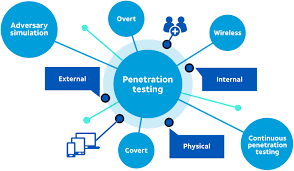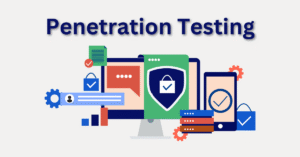In today’s digital landscape, businesses face ever-evolving cyber threats. A single exploit can disrupt operations, erode customer trust, and cost millions. This Complete Guide to Penetration Testing for Businesses (Pillar Article) presents an in-depth roadmap. You’ll learn what penetration testing entails, why it matters, and how to implement it as a core security strategy. By the end, you’ll hold an evergreen reference that drives both understanding and action.
Understanding Penetration Testing for Businesses
Penetration Testing for businesses, penetration testing simulates realistic cyberattacks to uncover system vulnerabilities. Ethical hackers mimic adversaries to reveal gaps before real attackers exploit them. Unlike passive vulnerability scans, penetration tests dive deeper. They actively probe networks, applications, and even human defenses. This hands-on approach ensures your security posture truly withstands threat scenarios.

Phase 1: Reconnaissance
Ethical hackers gather public and private data on your infrastructure. They map networks, research software versions, and identify potential entry points. This intelligence sets the stage for focused attacks.
Phase 2: Scanning
Automated tools like Nmap and Nessus scan for open ports, services, and outdated software. These tools highlight obvious flaws. Then, testers manually verify findings to reduce false positives.
Phase 3: Exploitation
Testers exploit confirmed weaknesses using frameworks such as Metasploit. They attempt SQL injections, buffer overflows, or misconfigurations. Each successful exploit reveals how an attacker could gain access.
Phase 4: Post-Exploitation
After initial access, ethical hackers evaluate the scope of damage. They escalate privileges, move laterally, and access sensitive data. This step measures the real-world impact of a breach.
Phase 5: Reporting & Remediation
Finally, testers deliver a detailed report. It includes proof-of-concepts, risk ratings, and clear remediation steps. Your team gains a prioritized action plan to close every identified gap.
Cybersecurity Statistics 2025: Why You Need Protection (Trends and Data)
Why Every Business Needs Penetration Testing
-
Proactive Defense. Spot hidden risks before criminals do.
-
Regulatory Compliance. Meet PCI-DSS, HIPAA, GDPR, and ISO mandates.
-
Cost Savings. Early fixes avoid breach fallout and downtime.
-
Reputation Protection. Prevent publicized breaches that damage brand trust.
-
Continuous Improvement. Regular tests keep pace with evolving threats.
Penetration Testing for Businesses that test often report a 50% reduction in successful intrusions within one year. Embedding penetration testing in your security lifecycle delivers lasting value.

Planning Your Penetration Testing Engagement
Planning Your Penetration Testing Engagement
-
Define Objectives. What assets matter most?
-
Set Scope. Choose networks, apps, and user groups to test.
-
Select Methodology. Follow industry standards like PTES or OWASP.
-
Establish Rules of Engagement. Agree on testing windows, data handling, and escalation paths.
-
Choose Test Type. Black-box (no prior data), white-box (full access), or grey-box (partial data).
Clear planning ensures efficient use of time and budget. It also prevents unexpected disruptions to your operations.
Common Tools & Techniques
-
Nmap: Network mapping and port scanning
-
Burp Suite: Web application proxy and vulnerability scanner
-
Metasploit: Exploit development and execution
-
Wireshark: Packet analysis
-
Hydra: Password brute-forcing
Pair these automated tools with custom scripts and manual testing. This hybrid approach uncovers both obvious and subtle flaws. For foundational definitions, see OWASP’s Web Security Testing Guide and NIST’s Technical Guide to Information Security Testing.
Choosing the Right Penetration Testing Partner
Penetration Testing for Businesses. When you need expert support, trust a proven provider. Our team follows a rigorous, transparent process. Learn our step-by-step approach in “How Our Ethical Hacking Services Work” naturally embedded test plans, and detailed reporting. Explore our ethical hacking services to see how we help businesses like yours.
Integrating Penetration Testing into Your Security Strategy
Penetration testing shines brightest when combined with broader security efforts. Consider pairing tests with:
-
Vulnerability Assessments: Routine scans to catch new flaws early (see our Vulnerability Assessment services).
-
Security Training: Regular phishing simulations and staff workshops.
-
Incident Response Plans: Tabletop exercises to refine breach protocols.
-
Continuous Monitoring: Real-time alerts for suspicious activity.
This holistic approach builds resilience and fosters a security-first culture.
Conclusion & Next Steps
Penetration testing stands as a cornerstone of any robust security program. This Complete Guide to Penetration Testing for Businesses (Pillar Article) equips you with practical steps—from reconnaissance to remediation. Armed with this knowledge, you can proactively defend critical assets, satisfy compliance mandates, and strengthen stakeholder trust.
Ready to secure your organization? Contact us today to schedule your first penetration test. Transform security from a checkbox exercise into a continuous defense strategy. Your business deserves nothing less than true resilience against emerging cyber threats.



No responses yet